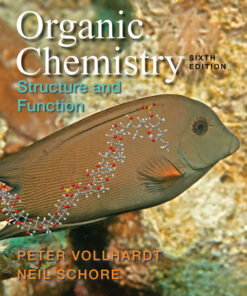Test Bank for Fundamentals of General, Organic, and Biological Chemistry, 7ed, John E. McMurry, David S. Ballantine, Carl A. Hoeger, Virginia E. Peterson
$35.00
Test Bank for Fundamentals of General, Organic, and Biological Chemistry, 7ed, John E. McMurry, David S. Ballantine, Carl A. Hoeger, Virginia E. Peterson
You will receive this product immediate after placing the order
Test Bank for Fundamentals of General, Organic, and Biological Chemistry, 7ed, John E. McMurry, David S. Ballantine, Carl A. Hoeger, Virginia E. Peterson, ISBN-10: 0321750112, ISBN-13: 9780321750112
This is not a textbook or e-book version of the original text. Its called TEST BANK contains Multiple Choice Questions with Answers. All chapter’s Tests are available. Buyer will receive the download (File type: pdf/word/exl..etc) in his email as soon as transaction completed. Please download sample for your confidential.
Table of Contents
1. Matter and Measurements
1.1 Chemistry: The Central Science
1.2 States of Matter
1.3 Classification of Matter
1.4 Chemical Elements and Symbols
1.5 Elements and the Periodic Table
1.6 Chemical Reaction: An Example of a Chemical Change
1.7 Physical Quantities
1.8 Measuring Mass, Length, and Volume
1.9 Measurement and Significant Figures
1.10 Scientific Notation
1.11 Rounding Off Numbers
1.12 Problem Solving: Unit Conversions and Estimating Answers
1.13 Temperature, Heat, and Energy
1.14 Density and Specific Gravity
2. Atoms and the Periodic Table
2.1 Atomic Theory
2.2 Elements and Atomic Number
2.3 Isotopes and Atomic Weight
2.4 The Periodic Table
2.5 Some Characteristics of Different Groups
2.6 Electronic Structure of Atoms
2.7 Electron Configurations
2.8 Electron Configurations and the Periodic Table
2.9 Electron-Dot Symbols
3. Ionic Compounds
3.1 Ions
3.2 Periodic Properties and Ion Formation
3.3 Ionic Bonds
3.4 Some Properties of Ionic Compounds
3.5 Ions and the Octet Rule
3.6 Ions of Some Common Elements
3.7 Naming Ions
3.8 Polyatomic Ions
3.9 Formulas of Ionic Compounds
3.10 Naming Ionic Compounds
3.11 H _ and OH _ Ions: An Introduction to Acids and Bases
4. Molecular Compounds
4.1 Covalent Bonds
4.2 Covalent Bonds and the Periodic Table
4.3 Multiple Covalent Bonds
4.4 Coordinate Covalent Bonds
4.5 Characteristics of Molecular Compounds
4.6 Molecular Formulas and Lewis Structures
4.7 Drawing Lewis Structures
4.8 The Shapes of Molecules
4.9 Polar Covalent Bonds and Electronegativity
4.10 Polar Molecules
4.11 Naming Binary Molecular Compounds
5. Classification and Balancing of Chemical Reactions
5.1 Chemical Equations
5.2 Balancing Chemical Equations
5.3 Classes of Chemical Reactions
5.4 Precipitation Reactions and Solubility Guidelines
5.5 Acids, Bases, and Neutralization Reactions
5.6 Redox Reactions
5.7 Recognizing Redox Reactions
5.8 Net Ionic Equations
6. Chemical Reactions: Mole and Mass Relationships
6.1 The Mole and Avogadro’s Number
6.2 Gram—Mole Conversions
6.3 Mole Relationships and Chemical Equations
6.4 Mass Relationships and Chemical Equations
6.5 Limiting Reagent and Percent Yield
7. Chemical Reactions: Energy, Rates, and Equilibrium
7.1 Energy and Chemical Bonds
7.2 Heat Changes during Chemical Reactions
7.3 Exothermic and Endothermic Reactions
7.4 Why Do Chemical Reactions Occur? Free Energy
7.5 How Do Chemical Reactions Occur? Reaction Rates
7.6 Effects of Temperature, Concentration, and Catalysts on Reaction Rates
7.7 Reversible Reactions and Chemical Equilibrium
7.8 Equilibrium Equations and Equilibrium Constants
7.9 Le Châtelier’s Principle: The Effect of Changing Conditions on Equilibria
8. Gases, Liquids, and Solids
8.1 States of Matter and Their Changes
8.2 Intermolecular Forces
8.3 Gases and the Kinetic—Molecular Theory
8.4 Pressure
8.5 Boyle’s Law: The Relation between Volume and Pressure
8.6 Charles’s Law: The Relation between Volume and Temperature
8.7 Gay-Lussac’s Law: The Relation between Pressure and Temperature
8.8 The Combined Gas Law
8.9 Avogadro’s Law: The Relation between Volume and Molar Amount
8.10 The Ideal Gas Law
8.11 Partial Pressure and Dalton’s Law
8.12 Liquids
8.13 Water: A Unique Liquid
8.14 Solids
8.15 Changes of State
9. Solutions
9.1 Mixtures and Solutions
9.2 The Solution Process
9.3 Solid Hydrates
9.4 Solubility
9.5 The Effect of Temperature on Solubility
9.6 The Effect of Pressure on Solubility: Henry’s Law
9.7 Units of Concentration
9.8 Dilution
9.9 Ions in Solution: Electrolytes
9.10 Electrolytes in Body Fluids: Equivalents and Milliequivalents
9.11 Properties of Solutions
9.12 Osmosis and Osmotic Pressure
9.13 Dialysis
10. Acids and Bases
10.1 Acids and Bases in Aqueous Solution
10.2 Some Common Acids and Bases
10.3 The Brønsted—Lowry Definition of Acids and Bases
10.4 Acid and Base Strength
10.5 Acid Dissociation Constants
10.6 Water as Both an Acid and a Base
10.7 Measuring Acidity in Aqueous Solution: pH
10.8 Working with pH
10.9 Laboratory Determination of Acidity
10.10 Buffer Solutions
10.11 Acid and Base Equivalents
10.12 Some Common Acid—Base Reactions
10.13 Titration
10.14 Acidity and Basicity of Salt Solutions
11. Nuclear Chemistry
11.1 Nuclear Reactions
11.2 The Discovery and Nature of Radioactivity
11.3 Stable and Unstable Isotopes
11.4 Nuclear Decay
11.5 Radioactive Half-Life
11.6 Radioactive Decay Series
11.7 Ionizing Radiation
11.8 Detecting Radiation
11.9 Measuring Radiation
11.10 Artificial Transmutation
11.11 Nuclear Fission and Nuclear Fusion
12. Introduction to Organic Chemistry: Alkanes
12.1 The Nature of Organic Molecules
12.2 Families of Organic Molecules: Functional Groups
12.3 The Structure of Organic Molecules: Alkanes and Their Isomers
12.4 Drawing Organic Structures
12.5 The Shapes of Organic Molecules
12.6 Naming Alkanes
12.7 Properties of Alkanes
12.8 Reactions of Alkanes
12.9 Cycloalkanes
12.10 Drawing and Naming Cycloalkanes
13. Alkenes, Alkynes, and Aromatic Compounds
13.1 Alkenes and Alkynes
13.2 Naming Alkenes and Alkynes
13.3 The Structure of Alkenes: Cis—Trans Isomerism
13.4 Properties of Alkenes and Alkynes
13.5 Types of Organic Reactions
13.6 Reactions of Alkenes and Alkynes
13.7 Alkene Polymers
13.8 Aromatic Compounds and the Structure of Benzene
13.9 Naming Aromatic Compounds
13.10 Reactions of Aromatic Compounds
14. Some Compounds with Oxygen, Sulfur, or a Halogen
14.1. Alcohols, Phenols, and Ethers
14.2. Some Common Alcohols
14.3. Naming Alcohols
14.4. Properties of Alcohols
14.5. Reactions of Alcohols
14.6. Phenols
14.7. Acidity of Alcohols and Phenols
14.8. Ethers
14.9. Thiols and Disulfides
14.10. Halogen-Containing Compounds
15. Amines
15.1. Amines
15.2. Properties of Amines
15.3. Heterocyclic Nitrogen Compounds
15.4. Basicity of Amines
15.5. Amine Salts
15.6. Amines in Plants: Alkaloids
16. Aldehydes and Ketones
16.1. The Carbonyl Group
16.2. Naming Aldehydes and Ketones
16.3. Properties of Aldehydes and Ketones
16.4. Some Common Aldehydes and Ketones
16.5. Oxidation of Aldehydes
16.6. Reduction of Aldehydes and Ketones
16.7. Addition of Alcohols: Hemiacetals and Acetals
17. Carboxylic Acids and their Derivatives
17.1. Carboxylic Acids and Their Derivatives: Properties and Names
17.2. Some Common Carboxylic Acids
17.3. Acidity of Carboxylic Acids
17.4. Reactions of Carboxylic Acids: Ester and Amide Formation
17.5. Aspirin and Other Over-the-Counter Carboxylic Acid
17.6. Hydrolysis of Esters and Amides
17.7. Polyamides and Polyesters
17.8. Phosphoric Acid Derivatives
18. Amino Acids and Proteins
18.1 An Introduction to Biochemistry
18.2 Protein Structure and Function: An Overview
18.3 Amino Acids
18.4 Acid—Base Properties of Amino Acids
18.5 Handedness
18.6 Molecular Handedness and Amino Acids
18.7 Primary Protein Structure
18.8 Shape-Determining Interactions in Proteins
18.9 Secondary Protein Structure
18.10 Tertiary Protein Structure
18.11 Quaternary Protein Structure
18.12 Chemical Properties of Proteins
19. Enzymes and Vitamins
19.1 Catalysis by Enzymes
19.2 Enzyme Cofactors
19.3 Enzyme Classification
19.4 How Enzymes Work
19.5 Effect of Concentration on Enzyme Activity
19.6 Effect of Temperature and pH on Enzyme Activity
19.7 Enzyme Regulation: Feedback and Allosteric Control
19.8 Enzyme Regulation: Inhibition
19.9 Enzyme Regulation: Covalent Modification and Genetic Control
19.10 Vitamins and Minerals
20. The Generation of Biochemical Energy
20.1. Energy and Life
20.2. Energy and Biochemical Reactions
20.3. Cells and Their Structure
20.4. An Overview of Metabolism and Energy Production
20.5. Strategies of Metabolism: ATP and Energy Transfer
20.6. Strategies of Metabolism: Metabolic Pathways and Coupled Reactions
20.7. Strategies of Metabolism: Oxidized and Reduced Coenzymes
20.8. The Citric Acid Cycle
20.9. The Electron-Transport Chain and ATP Production
20.10. Harmful Oxygen By-Products and Antioxidant Vitamins
21. Carbohydrates
21.1 An Introduction to Carbohydrates
21.2. Handedness of Carbohydrates
21.3. The D and L Families of Sugars: Drawing Sugar Molecules
21.4. Structure of Glucose and Other Monosaccharides
21.5. Some Important Monosaccharides
21.6. Reactions of Monosaccharides
21.7. Disaccharides
21.8. Variations on the Carbohydrate Theme
21.9. Some Important Polysaccharides
22. Carbohydrate Metabolism
22.1. Digestion of Carbohydrates
22.2. Glucose Metabolism: An Overview
22.3. Glycolysis
22.4. Entry of Other Sugars into Glycolysis
22.5. The Fate of Pyruvate
22.6. Energy Output in Complete Catabolism of Glucose
22.7. Regulation of Glucose Metabolism and Energy Production
22.8. Metabolism in Fasting and Starvation
22.9. Metabolism in Diabetes Mellitus
22.10. Glycogen Metabolism: Glycogenesis and Glycogenolysis
22.11. Gluconeogenesis: Glucose from Noncarbohydrates
23. Lipids
23.1. Structure and Classification of Lipids
23.2. Fatty Acids and Their Esters
23.3. Properties of Fats and Oils
23.4. Chemical Reactions of Triacylglycerols
23.5. Phospholipids and Glycolipids
23.6. Sterols
23.7. Structure of Cell Membranes
23.8. Transport Across Cell Membranes
23.9. Eicosanoids: Prostaglandins and Leukotrienes
24. Lipid Metabolism
24.1 Digestion of Triacylglycerols
24.2. Lipoproteins for Lipid Transport
24.3. Triacylglycerol Metabolism: An Overview
24.4. Storage and Mobilization of Triacylglycerols
24.5. Oxidation of Fatty Acids
24.6. Energy from Fatty Acid Oxidation
24.7. Ketone Bodies and Ketoacidosis
24.8. Biosynthesis of Fatty Acids
25. Nucleic Acids and Protein Synthesis
25.1. DNA, Chromosomes, and Genes
25.2. Composition of Nucleic Acids
25.3. The Structure of Nucleic Acid Chains
25.4. Base Pairing in DNA: The Watson—Crick Model
25.5. Nucleic Acids and Heredity
25.6. Replication of DNA
25.7. Structure and Function of RNA
25.8. Transcription: RNA Synthesis
25.9. The Genetic Code
25.10. Translation: Transfer RNA and Protein Synthesis
26. Genomics
26.1. Mapping the Human Genome
26.2. A Trip Along a Chromosome
26.3. Mutations and Polymorphisms
26.4. Recombinant DNA
26.5. Genomics: Using What We Know
27. Protein and Amino Acid Metabolism
27.1. Digestion of Proteins
27.2. Amino Acid Metabolism: An Overview
27.3. Amino Acid Catabolism: The Amino Group
27.4. The Urea Cycle
27.5. Amino Acid Catabolism: The Carbon Atoms
27.6. Biosynthesis of Nonessential Amino Acids
28. Chemical Messengers: Hormones, Neurotransmitters, and Drugs
28.1. Messenger Molecules
28.2. Hormones and the Endocrine System
28.3. How Hormones Work: Epinephrine and Fight-or-Flight
28.4. Amino Acid Derivatives and Polypeptides as Hormones
28.5. Steroid Hormones
28.6. Neurotransmitters
28.7. How Neurotransmitters Work: Acetylcholine, Its Agonists and Antagonists
28.8. Histamine and Antihistamines
28.9. Serotonin, Norepinephrine, and Dopamine
28.10. Neuropeptides and Pain Relief
28.11. Drug Discovery and Drug Design
29. Body Fluids
29.1 Body Water and Its Solutes
29.2. Fluid Balance
29.3. Blood
29.4. Plasma Proteins, White Blood Cells, and Immunity
29.5. Blood Clotting
29.6. Red Blood Cells and Blood Gases
29.7. The Kidney and Urine Formation
29.8. Urine Composition and Function












Reviews
There are no reviews yet.